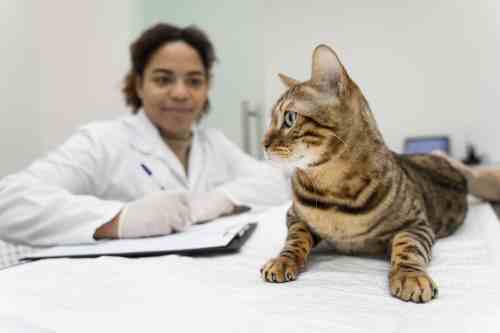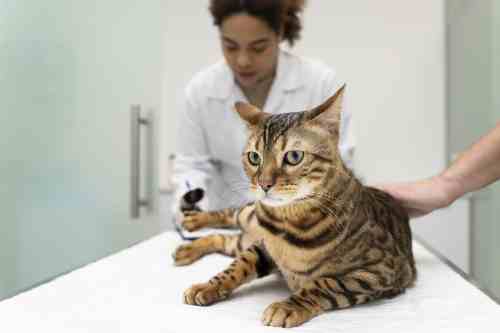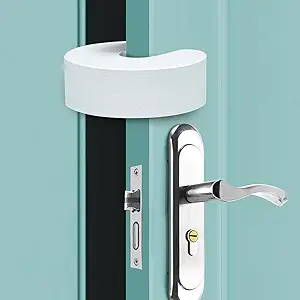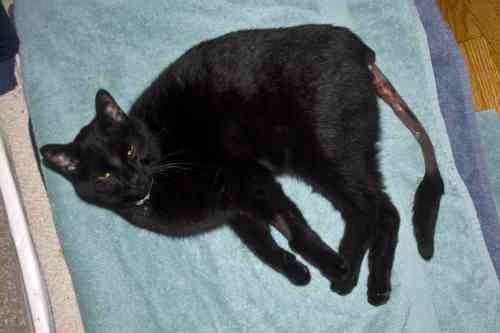Your cat got his tail slammed in the door
What to do now?
It happens to every cat owner at least once. If you close the door behind you too quickly, it turns out that your cat also wants to pass as well. Result: your cat got his tail slammed in the door. Super awful of course. For both your cat and for you because you feel guilty. In this article we will tell you what to check for in your cat’s tail and what you can do yourself to treat it. And of course also when it is better to go to your vet.
How bad is it if your cat gets his tail slammed in the door?
In most cases, it just happens to go well (enough) and your cat does not suffer any major damage to his tail when it gets caught in the door. But your cat may be one of the unlucky ones. A tail may have been broken by the force of the door. But a bruised tail or wounds on your cat’s tail can also occur as a result of being slammed in the door. That is why it is important that you know what symptoms you may notice so you can determine for yourself whether serious damage has occurred to your cat’s tail.
In addition to the injuries, according to research done by Curt Walker, Charles J. Vierck Jr. and Louis A. Ritz tails are also important for your cat to maintain his balance. If his tail functions less well, it will fall more easily from a great height. As a result, the consequential damage can of course cause even more misery.
And don’t forget that cats also communicate with each other with the position of their tail. This is evident from research conducted by S. Cafazzoa and E. Natoli. If your cat can no longer move his tail properly, he may have more problems with other cats.
What symptoms could you see when your cat has gotten his tail stuck in the door?
Below we explain to you per medical problem what symptoms you may notice in your cat’s tail if it has been stuck in the door.
A broken tail
- The tail may be bent at an angle
- The tail is very painful
- His skin may look more red than normal in some cases
- Your cat often holds his tail lower than normal
- There is less movement in his tail
- His tail may be swollen
- Your cat may have less feeling in his tail
- He may spend a lot more time licking or biting his tail.
A bruised tail
Wounds in the skin of the tail
- In some places the skin no longer contains any skin and looks abraded
- His skin may be completely torn through, allowing you to see the underlying tissues (muscles and tendons).
- Blood may be visible on your cat’s tail or in the house
- The tail can be painful
- He holds his tail lower than he is used to
- They usually still move the tail in a normal way, but perhaps less intensively
- He will lick his tail more to clean the wound.
The first steps you should take when your cat got his tail stuck in the door
Keep calm after your cat got his tail slammed in the door
Cats are extremely sensitive to stress. As soon as they sense that you as the owner are stressed, they will be much less cooperative in examining their tail. And of course you are shocked by the fact that your cat got his tail stuck in the door and are therefore stressed. Make sure your cat can’t escape outside for a while. But then take 5 minutes to calm yourself down and let your cat recover from his own shock. Then you will both be better able to examine his tail and see what the damage is. As we said before, in most cases there is hardly anything wrong. You just need to know for sure.
Look at the tail without touching it
Give your cat a treat so that he will be more cooperative in examining his tail. You always start by looking at the position of the tail from a distance. Assess whether your cat holds his tail in a kink, whether he holds it lower than you are used to and whether you can see signs of a wound without feeling it.
Feel the tail to determine abnormalities
As soon as you touch your cat’s tail, this could be painful for him. It is therefore always better to have someone hold your cat so you can feel his tail. After all, he would probably rather walk away from you if you hurt him while examining him. Always be aware that your cat can react really angrily and is capable of biting or scratching you. In some cases it can help to wrap your cat in a towel to make it less easy for him to bite and scratch.
You can feel his tail to see if all the tail bones are still in one straight line. After all, you mainly want to know whether your cat broke his tail while getting it slammed in the door. Start at the level of his pelvis and slowly move towards the back. In addition, try to feel whether there is a lot of swelling locally somewhere in the tail. Also carefully feel whether the skin is still intact everywhere. Are you unsure about wounds? Then you can rub the fur to the side and see if you see any wounds.
In case of a hanging tail, check if he still has feeling in it
Is your cat’s tail hanging all the way down? Then it may be that nerves are damaged. In that case, your cat may no longer feel the tip of his tail. In that case, pinch the tip of his tail (in an area where there is no injury, of course) and see if he shows any signs of recognizing the pinch. You should see your cat wriggling his body, meowing, or trying to pull his tail away. Can’t you see all this happening and can you really squeeze him hard without any reaction? Then he no longer has feeling in his tail.
When is it better to go to your vet if your cat got his tail slammed in the door?
If your cat has large wounds on his tail as a result of being stuck in the door, it is better to take it to your vet. They may then suggest suturing the wounds under anesthesia in case that is necessary.
If your cat has broken his tail, it is also better to take him to your vet. If in doubt, he or she can take an X-ray to be sure. If his tail is crooked, it may be necessary to have his tail straightened. If his tail is not too crooked, it is usually decided to let it heal on its own without further treatment. A cat’s tail is very capable of healing itself.
Is your cat’s tail dragging on the ground? Then it is better to have your vet see what is wrong. There is a chance that there is nerve damage. If the tail continues to drag on the ground, his skin will chafe and wounds will occur. In such cases it may be better to provide his tail with extra protection against chafing. If no recovery has occurred after a month, it is usually decided to surgically shorten the tail slightly so that it no longer drags on the ground and no more wounds can occur.
What can you do yourself if your cat got his tail slammed in the door?
If the damage to your cat’s tail is not too serious, you can treat it yourself at home and let it heal on its own.
Treating wounds
Do you see any wounds on your cat’s tail and are they smaller than 0.2 inch? Then they can heal themselves without you having to go to your vet. It is important that your cat does not get an infection. That is why you should disinfect the wounds with iodine ointment.
In the following days it is better to rub the wounds on his tail with honey ointment twice a day. This ensures that bacteria can’t grow as well and stimulates wound healing. This prevents the wound from developing an infection.
Treating bruises
If your cat’s tail has only just been stuck in the door, it is wise to cool his tail with a cool pack where the door has trapped his tail. The cold causes the blood vessels to contract and therefore less fluid to seep out of the blood vessels. This way you prevent his tail from swelling up.
In the days after your cat has had his tail between the door, you can help heal his tail by applying warm compresses to it. Two to three times a day for fifteen minutes. It is usually sufficient to do this for about five days. The heat causes the blood vessels in his tail to open a little wider, allowing more blood to flow to your cat’s bruised tail. The more blood, the more healing substances come to that region. And therefore the faster your cat’s tail will heal. You can also use the above cool pack as a heat compress. However, we personally find a cherry stone pillow easier to use with cats.
Reduce pain
It is best to use a painkiller that your vet has prescribed for your cat. But you will usually not receive it from your vet if you have not had a consultation with your cat. In that case, you can give your cat Aspirin. NB! ONLY ASPIRIN IS SUITABLE! PARACETAMOL, IBUPROFEN OR OTHER PAIN KILLERS FOR HUMANS ARE FATAL TO CATS. You can give your cat half a tablet of a 81mg aspirin tablet once every 2 days (not twice a day!). You may do this for a maximum of 7 days.
And a broken tail?
If your cat’s tail is broken, but is in a straight position, your vet will not do much about it. Your cat will be given a painkiller. But otherwise we recommend keeping your cat indoors and prevent a lot of movement.
How do you prevent your cat from getting his tail stuck in the door again in the future?
It goes without saying, but in the future it is important to take into account the fact that your cat can run after you very suddenly. So check the door before you close it behind you and try to learn yourself to close the door slowly without too much force.
If you want to take extra precautions, you can provide the doors with a door stop.
Get well soon!
Hopefully your cat has also learned something from his tail-in-the-door adventure. If your cat was one of the unlucky ones with some damage to his tail, we wish him a speedy recovery and for you good luck with his treatment. His tail will probably look like new again soon! And don’t forget to buy a door stop now!









